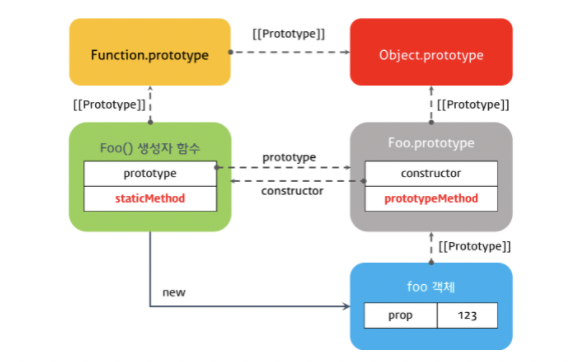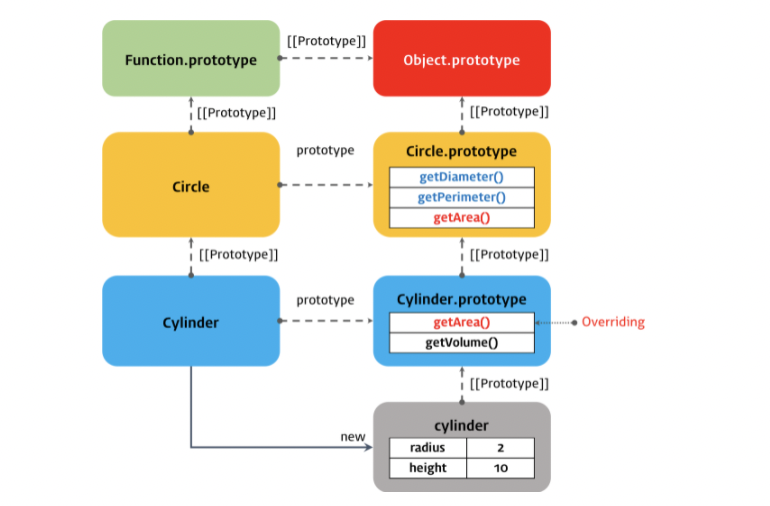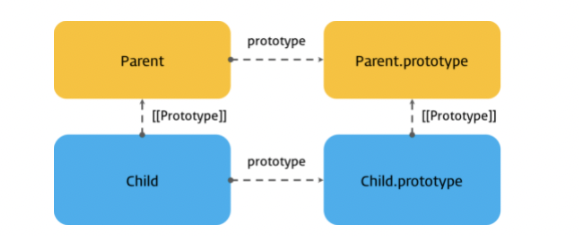
클래스 정의 (Class Definition)
ES6 클래스는
class키워드를 사용하여 정의한다.
클래스 이름은 생성자 함수와 마찬가지로 파스칼 케이스를 사용하는 것이 일반적인 규칙이다.
// 클래스 선언문
class Person {
// constructor(생성자)
constructor(name) {
this._name = name;
}
sayHi() {
console.log(`Hi! ${this._name}`);
}
}
// 인스턴스 생성
const me = new Person('Lee');
me.sayHi(); // Hi! Lee
console.log(me instanceof Person); // true
// 클래스는 클래스 선언문 이전에 참조할 수 없다.
console.log(Foo);
// ReferenceError: Cannot access 'Foo' before initialization class Foo {}
const Foo = '';하지만 호이스팅이 발생하지 않는 것은 아니다.
클래스는 var 키워드로 선언한 변수처럼 호이스팅되지 않고 let, const 키워드로 선언한 변수처럼 호이스팅된다.
따라서 클래스 선언문 이전에 일시적 사각지대(Temporal Dead Zone; TDZ)에 빠지기 때문에 호이스팅이 발생하지 않는 것처럼 동작한다.
일반적이지는 않지만, 표현식으로도 클래스를 정의할 수 있다.
함수와 마찬가지로 클래스는 이름을 가질 수도 갖지 않을 수도 있다.
// 클래스명 MyClass는 함수 표현식과 동일하게 클래스 몸체 내부에서만 유효한 식별자이다.
const Foo = class MyClass {};
const foo = new Foo();
console.log(foo); // MyClass {}
new MyClass(); // ReferenceError: MyClass is not defined인스턴스 생성
생성자 함수와 같이
new연산자와 함께 클래스 이름을 호출하면 클래스의 인스턴스가 생성된다.
class Foo {}
const foo = new Foo();
const foo = Foo(); // TypeError: Class constructor Foo cannot be invoked without 'new'위 코드에서 new 연산자와 함께 호출한 Foo는 클래스의 이름이 아니라 constructor(생성자)이다.
표현식이 아닌 선언식으로 정의한 클래스의 이름은 생성자와 동일하다.
new 연산자를 사용하지 않고 생성자를 호출하면 타입 에러(TypeError)가 발생한다.
constructor
인스턴스를 생성하고 클래스 필드를 초기화하기 위한 특수한 메소드이다.
클래스 필드(class field)
클래스 내부의 캡슐화된 변수를 말하며 데이터 멤버 또는 멤버 변수라고도 부른다.
클래스 필드는 인스턴스의 프로퍼티 또는 정적 프로퍼티가 될 수 있다.
// 클래스 선언문
class Person {
// constructor(생성자). 이름을 바꿀 수 없다.
constructor(name) {
// this는 클래스가 생성할 인스턴스를 가리킨다.
// _name은 클래스 필드이다.
this._name = name;
}
}
// 인스턴스 생성
const me = new Person('Lee');
console.log(me); // Person {_name: "Lee"}constructor는 클래스 내에 한 개만 존재할 수 있으며 만약 클래스가 2개 이상의 constructor를 포함하면 문법 에러(SyntaxError)가 발생한다.
인스턴스를 생성할 때 new 연산자와 함께 호출한 것이 바로 constructor이며 constructor의 파라미터에 전달한 값은 클래스 필드에 할당한다.
constructor를 생략하면 클래스에 constructor() {}를 포함한 것과 동일하게 동작한다.
constructor는 인스턴스의 생성과 동시에 클래스 필드의 생성과 초기화를 실행하므로 클래스 필드를 초기화해야 한다면 constructor를 생략해서는 안된다.
클래스 필드
클래스 몸체(class body)에는 메소드만 선언할 수 있다.
클래스 바디에 클래스 필드(멤버 변수)를 선언하면 문법 에러(SyntaxError)가 발생한다.
따라서 클래스 필드의 선언과 초기화는 반드시 constructor 내부에서 실시한다.
class Foo {
age = ''; // SyntaxError
constructor(name = '') {
this.name = name; // 클래스 필드의 선언과 초기화
}
}
const foo = new Foo('Lee');
console.log(foo); // Foo { name: 'Lee' }constructor 내부에서 선언한 클래스 필드는 클래스가 생성할 인스턴스를 가리키는 this에 바인딩한다.
이로써 클래스 필드는 클래스가 생성할 인스턴스의 프로퍼티가 되며, 클래스의 인스턴스를 통해 클래스 외부에서 언제나 참조할 수 있다.
즉, 언제나 public이다.
ES6의 클래스는 다른 객체지향 언어처럼 private, public, protected 키워드와 같은 접근 제한자를 지원하지 않는다.
class Foo {
constructor(name = '') {
this.name = name; // public 클래스 필드
}
}
const foo = new Foo('Lee');
console.log(foo.name); // 클래스 외부에서 참조할 수 있다.Class field declarations proposal
class Foo {
x = 1; // Field declaration
#p = 0; // Private field
static y = 20; // Static public field
static #sp = 30; // Static private field
bar() {
this.#p = 10; // private 필드 참조
return this.#p;
}
}2019년 5월 TC39 프로세스의 stage 3(candidate) 단계에 있는 클래스 몸체에서 직접 인스턴스 필드를 선언하고 private 인스턴스 필드를 선언할 수 있는 프로포절 Class field declarations proposal의 Field declarations을 최신 브라우저와 최신 Node.js가 구현했다.
따라서 위 예제는 최신 브라우저(Chrome 72 이상) 또는 최신 Node.js(버전 12 이상)에서 정상 동작한다
getter
클래스 필드에 접근할 때마다 클래스 필드의 값을 조작하는 행위가 필요할 때 사용한
메소드 이름 앞에 get 키워드를 사용해 정의한다.
이 때 메소드 이름은 클래스 필드 이름처럼 사용된다.
다시 말해 getter는 호출하는 것이 아니라 프로퍼티처럼 참조하는 형식으로 사용하며 참조 시에 메소드가 호출된다.
getter는 이름 그대로 무언가를 취득할 때 사용하므로 반드시 무언가를 반환해야 한다.
class Foo {
constructor(arr = []) {
this._arr = arr;
}
// getter: get 키워드 뒤에 오는 메소드 이름 firstElem은 클래스 필드 이름처럼 사용된다.
get firstElem() {
// getter는 반드시 무언가를 반환해야 한다.
return this._arr.length ? this._arr[0] : null;
}
}
const foo = new Foo([1, 2]);
// 필드 firstElem에 접근하면 getter가 호출된다.
console.log(foo.firstElem); // 1setter
클래스 필드에 값을 할당할 때마다 클래스 필드의 값을 조작하는 행위가 필요할 때 사용한다.
메소드 이름 앞에 set 키워드를 사용해 정의한다.
이 때 메소드 이름은 클래스 필드 이름처럼 사용된다.
다시 말해 setter는 호출하는 것이 아니라 프로퍼티처럼 값을 할당하는 형식으로 사용하며 할당 시에 메소드가 호출된다.
class Foo {
constructor(arr = []) {
this._arr = arr;
}
// setter: set 키워드 뒤에 오는 메소드 이름 firstElem은 클래스 필드 이름처럼 사용된다.
set firstElem(elem) {
// ...this._arr은 this._arr를 개별 요소로 분리한다
this._arr = [elem, ...this._arr];
}
}
const foo = new Foo([1, 2]);
// 클래스 필드 firstElem에 값을 할당하면 setter가 호출된다.
foo.firstElem = 100;
console.log(foo._arr); // [100, 1, 2]정적 메소드
클래스의 정적(static) 메소드를 정의할 때 static 키워드를 사용한다.
정적 메소드는 클래스의 인스턴스가 아닌 클래스 이름으로 호출한다.
따라서 클래스의 인스턴스를 생성하지 않아도 호출할 수 있다.
class Foo {
constructor(prop) {
this.prop = prop;
}
static staticMethod() {
/*
정적 메소드는 this를 사용할 수 없다.
정적 메소드 내부에서 this는 클래스의 인스턴스가 아닌 클래스 자신을 가리킨다.
*/
return 'staticMethod';
}
prototypeMethod() {
return this.prop;
}
}
// 정적 메소드는 클래스 이름으로 호출한다.
// 인스턴스를 생성하지 않아도 호출할 수 있다.
console.log(Foo.staticMethod());
const foo = new Foo(123);
// 정적 메소드는 인스턴스로 호출할 수 없다.
console.log(foo.staticMethod()); // Uncaught TypeError: foo.staticMethod is not a function클래스의 정적 메소드는 인스턴스로 호출할 수 없다.
이것은 정적 메소드는 this를 사용할 수 없다는 것을 의미한다.
일반 메소드 내부에서 this는 클래스의 인스턴스를 가리키므로 메소드 내부에서 this를 사용한다는 것은 클래스의 인스턴스의 생성을 전제로 하는 것이다.
달리 말하면 메소드 내부에서 this를 사용할 필요가 없는 메소드는 정적 메소드로 만들 수 있다.
정적 메소드는 Math 객체의 메소드처럼 애플리케이션 전역에서 사용할 유틸리티(utility) 함수를 생성할 때 주로 사용한다.
정적 메소드는 클래스의 인스턴스 생성없이 클래스의 이름으로 호출하며 클래스의 인스턴스로 호출할 수 없다고 하였는데 그 이유에 대해 좀 더 자세히 살펴보자.
class Foo {
constructor(prop) {
this.prop = prop;
}
static staticMethod() {
return 'staticMethod';
}
prototypeMethod() {
return this.prop;
}
}
위 예제를 ES5로 표현해보면 아래와 같다. ES5로 표현한 아래의 코드는 ES6의 클래스로 표현한 코드와 정확히 동일하게 동작한다.
var Foo = (function () {
// 생성자 함수
function Foo(prop) {
this.prop = prop;
}
// Foo 함수에 staticMethod를 바인딩한다.
Foo.staticMethod = function () {
return 'staticMethod';
};
// Foo.prototype 객체에 prototypeMethod 메소드를 바인딩한다.
// Foo.prototype은 Foo로 생성되는 인스턴스의 부모 역할을 한다.
// 다시말해 Foo로 생성되는 인스턴스의 [[Prototype]]은 Foo.prototype을 가리킨다.
// 즉 Foo로 생성되는 인스턴스는 프로토타입 체인을 통해 prototypeMethod 메소드를 사용할 수 있다.
Foo.prototype.prototypeMethod = function () {
return this.prop;
};
return Foo;
}());
var foo = new Foo(123);
console.log(Foo.prototype === foo.__proto__); // true
console.log(foo.prototypeMethod()); // 123
console.log(Foo.staticMethod()); // staticMethod
console.log(foo.staticMethod()); // Uncaught TypeError: foo.staticMethod is not a function-
정적 메소드인
staticMethod
생성자 함수Foo자체의 메소드(클래스는 함수이고, 함수는 객체이므로 메소드를 가질 수 있다.) -
일반 메소드인
prototypeMethod
프로토타입 객체Foo.prototype의 메소드이다.
따라서 staticMethod는 foo에서 호출할 수 없다.
지금까지 설명한 내용을 프로토타입 체인 관점에서 표현하면 아래와 같다.

클래스 상속
클래스 상속(Class Inheritance)은 코드 재사용 관점에서 매우 유용하다.
새롭게 정의할 클래스가 기존에 있는 클래스와 매우 유사하다면, 상속을 통해 그대로 사용하되 다른 점만 구현하면 된다.
extends 키워드
부모 클래스를 상속받는 자식 클래스를 정의할 때 사용한다.
부모 클래스 Circle을 상속받는 자식 클래스 Cylinder를 정의해 보자.
// 부모 클래스
class Circle {
constructor(radius) {
this.radius = radius; // 반지름
}
// 원의 지름
getDiameter() {
return 2 * this.radius;
}
// 원의 둘레
getPerimeter() {
return 2 * Math.PI * this.radius;
}
// 원의 넓이
getArea() {
return Math.PI * Math.pow(this.radius, 2);
}
}
// 자식 클래스
class Cylinder extends Circle {
constructor(radius, height) {
super(radius);
this.height = height;
}
// 원통의 넓이: 부모 클래스의 getArea 메소드를 오버라이딩하였다.
getArea() {
// (원통의 높이 * 원의 둘레) + (2 * 원의 넓이)
return (this.height * super.getPerimeter()) + (2 * super.getArea());
}
// 원통의 부피
getVolume() {
return super.getArea() * this.height;
}
}
// 반지름이 2, 높이가 10인 원통
const cylinder = new Cylinder(2, 10);
// 원의 지름
console.log(cylinder.getDiameter()); // 4
// 원의 둘레
console.log(cylinder.getPerimeter()); // 12.566370614359172
// 원통의 넓이
console.log(cylinder.getArea()); // 150.79644737231007
// 원통의 부피
console.log(cylinder.getVolume()); // 125.66370614359172
// cylinder는 Cylinder 클래스의 인스턴스이다.
console.log(cylinder instanceof Cylinder); // true
// cylinder는 Circle 클래스의 인스턴스이다.
console.log(cylinder instanceof Circle); // true-
오버라이딩(Overriding)
상위 클래스가 가지고 있는 메소드를 하위 클래스가 재정의하여 사용하는 방식이다. -
오버로딩(Overloading)
매개변수의 타입 또는 갯수가 다른, 같은 이름의 메소드를 구현하고 매개변수에 의해 메소드를 구별하여 호출하는 방식이다.
자바스크립트는 오버로딩을 지원하지 않지만arguments객체를 사용하여 구현할 수는 있다.
위 코드를 프로토타입 관점으로 표현하면 아래와 같다. 인스턴스 cylinder는 프로토타입 체인에 의해 부모 클래스 Circle의 메소드를 사용할 수 있다.

cylinder.__proto__ === Cylinder.prototype // true
Cylinder.prototype.__proto__ === Circle.prototype // true
Circle.prototype.__proto__ === Object.prototype // true
Object.prototype.__proto__ === null // truesuper 키워드
부모 클래스를 참조하거나 부모 클래스의
constructor를 호출할 때 사용한다.
위 “extends 키워드”의 예제를 보면 super가 메소드로 사용될 때, 그리고 객체로 사용될 때 다르게 동작하는 것을 알 수 있다.
// 부모 클래스
class Circle {
...
}
class Cylinder extends Circle {
constructor(radius, height) {
// 1. super 메소드는 부모 클래스의 constructor를 호출하면서 인수를 전달한다.
super(radius);
this.height = height;
}
// 원통의 넓이: 부모 클래스의 getArea 메소드를 오버라이딩하였다.
getArea() {
// (원통의 높이 * 원의 둘레) + (2 * 원의 넓이)
// 2. super 키워드는 부모 클래스(Base Class)에 대한 참조
return (this.height * super.getPerimeter()) + (2 * super.getArea());
}
// 원통의 부피
getVolume() {
// 2. super 키워드는 부모 클래스(Base Class)에 대한 참조
return super.getArea() * this.height;
}
}
// 반지름이 2, 높이가 10인 원통
const cylinder = new Cylinder(2, 10);-
super메소드
자식 클래스의constructor내부에서 부모 클래스의constructor를 호출한다.
즉, 부모 클래스의 인스턴스를 생성한다.
자식 클래스의constructor에서super()를 호출하지 않으면this에 대한 참조 에러(ReferenceError)가 발생한다. -
super키워드
부모 클래스(Base Class)에 대한 참조이다.
부모 클래스의 필드 또는 메소드를 참조하기 위해 사용한다.
static 메소드와 prototype 메소드의 상속
프로토타입 관점에서 바라보면 자식 클래스의 [[Prototype]] 내부 슬롯이 가리키는 프로토타입 객체는 부모 클래스이다.
class Parent {}
class Child extends Parent {}
console.log(Child.__proto__ === Parent); // true
console.log(Child.prototype.__proto__ === Parent.prototype); // true자식 클래스 Child의 프로토타입 객체는 부모 클래스 Parent이다. 이것을 그림으로 표현해보면 아래와 같다.

즉 자식 클래스의 프로토타입 객체는 부모 클래스이다
이것은 Prototype chain에 의해 부모 클래스의 정적 메소드도 상속됨을 의미한다.
class Parent {
static staticMethod() {
return 'staticMethod';
}
}
class Child extends Parent {}
console.log(Parent.staticMethod()); // 'staticMethod'
console.log(Child.staticMethod()); // 'staticMethod'자식 클래스의 정적 메소드 내부에서도 super 키워드를 사용하여 부모 클래스의 정적 메소드를 호출할 수 있다.
하지만 자식 클래스의 일반 메소드 내부에서는 super 키워드를 사용하여 부모 클래스의 정적 메소드를 호출할 수 없다.
자식 클래스의 인스턴스는 프로토타입 체인에 의해 부모 클래스의 정적 메소드를 참조할 수 없기 때문이다.
(자식 클래스의 인스턴스의 [[Prototype]]은 자식 클래스가 아니라 자식 클래스의 프로토타입 객체를 가리키고, 자식 클래스의 프로토타입 객체의 [[Prototype]]은 부모 클래스가 아니라 부모 클래스의 프로토타입 객체를 가리킨다.)
class Parent {
static staticMethod() {
return 'Hello';
}
}
class Child extends Parent {
static staticMethod() {
return `${super.staticMethod()} wolrd`;
}
prototypeMethod() {
return `${super.staticMethod()} wolrd`;
}
}
console.log(Parent.staticMethod()); // 'Hello'
console.log(Child.staticMethod()); // 'Hello wolrd'
console.log(new Child().prototypeMethod());
// TypeError: (intermediate value).staticMethod is not a functionReference
https://poiemaweb.com/es6-class
